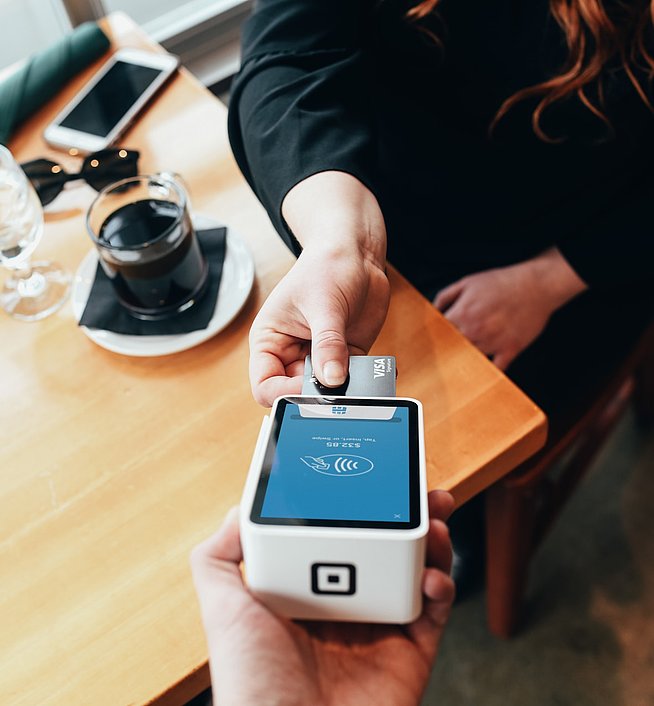Hauptinhalt

BNPL is the umbrella term for various new “delayed payment” financing options. In general, the aim is to provide consumers with more flexible, tailor-made payment options. This ranges from a later payment target (“purchase on account”) through installment payments (typically 3-12 installments) to installment loans (typical loan-mostly for high-priced products). BNPL has become one of the most important fintech trends worldwide in recent years. Especially in retail and eCommerce, BNPL offers are crucial for success.
Benefits for customers: BNPL tools give consumers more options to afford products and services with certainty. The top two BNPL methods are in eCommerce-purchase on account and installment purchase.
Benefits for merchants: From an online merchant perspective, BNPL represents the opportunity to improve conversion rates, increase shopping carts and close more deals.
Advantages for banks: Financial institutes have the opportunity to make their financing solutions available directly in the (online) shops and thus have a new sales channel. Thanks to “Embedded Finance” they are seamlessly integrated directly into the purchase process.
Embedded finance describes the approach when financial services are integrated as a direct part of products and services, usually by companies outside of the traditional banking industry. While banks have previously sold their financial services directly to customers, this model offers a new and more customer-oriented process: financial service providers move their offerings to where the customer pays. This makes them an integral part of the customer journey and thus serves the need for a financial service exactly where it arises.
This applies in particular to purchases on the Internet, where many retailers now naturally also offer installment loans or 0% financing in the check-out process. But stationary retail is now also emulating online shops and offers attractive financing options with the help of financial partners or their own financial institutions, which are made possible in the background by fintechs.
Embedded financial services mean that any digital company can become a FinTech. When used correctly, banks, retailers, and fintechs benefit equally.
Embedded finance is not only about technologies, but also about banks themselves. Fintechs like Credi2 are a reliable tech partner for banks that want to further automate their lending business and thus become more efficient on the one hand and open up new sales channels on the other. Some examples are:
FINANCE A BIKE: Online bicycle financing is implemented together with the Volkswagen Bank.
cashpresso: The installment payment app is being implemented together with Raiffeisen Bank International (RBI).
A white-label is a product or service that is not marketed under its own brand but under the brand of partner companies. This model is well established in the software sector; for example when new solutions from tech companies are integrated into apps or digital offerings from banks or retailers. White-label solutions allow companies to quickly launch new services without having to develop them from scratch themselves. BaaS or embedded finance solutions typically follow the white-label approach.
Buying a car, traveling around the world, training, purchasing furniture: consumers can take out consumer credit for more expensive consumer goods, services, or phases of life. These often represent an alternative to installment payments. Depending on the provider, there are variable or fixed interest rates for consumer credit, flexibly selectable terms, and different rates.
It is a loan with a fixed interest rate and a fixed term and is used to finance larger purchases. The installment loan is usually repaid monthly by the borrower in equal installments. Depending on the provider, installment breaks or early repayment are often possible.
This is a mixed form of the overdraft facility and installment loan. The customer of a bank is granted a credit line of a certain amount (e.g. €20,000), which he or she can draw on if necessary up to the agreed maximum limit. The amount depends, among other things, on the creditworthiness and income situation of the borrower and the liquidity of the company.
The motto is: rent instead of buying. What we already know from the world of real estate and mobile phone contracts is now being extended to many other areas of life thanks to new technologies. Many products and services are available with subscriptions: music, TV series, audiobooks, e-bikes, e-cars, smartwatches, smartphones, or notebooks. Instead of buying a product or service, you could simply pay a monthly fee to use it for as long as you need it.
Today, subscription models can appeal to very large target groups. According to a credi2 study, almost half of 18 to 34-year-olds no longer prioritize possessions. Six out of ten customers consider subscription models to be financially more attractive than buying a product, and 70% of those surveyed believe that subscription models give them more financial flexibility. Furthermore, customers of Generation Y & Z welcome the fact that physical products are more sustainable since they are either recycled after the return or professionally returned to the circular economy.
Advantages for customers:
Whether an e-bike, notebook, smartwatch, or smartphone, higher-priced products are suddenly affordable for a broader group of consumers because there are monthly subscription payments instead of a one-off purchase price. Depending on the subscription model, the residual value of the product is also deducted and the rent reduced – similar to leasing. Also, customers can quickly and easily upgrade to a new model of the product and return the old device to the retailer.
Advantages for merchants:
Subscription models have the advantage that they can bind customers to the merchant for a longer period of time. After the end of the subscription, the latest device is usually automatically made available again and the customer is retained in the long term. In addition, the conversion rate is higher because monthly payments make higher-priced products more affordable.
Companies and consumers make a contribution to the circular economy through the 10 Re’s:
- Refuse: Only buy/use things that you really need; Avoid certain raw materials
- Rethink: The first step is often a rethink; for example when companies change their business model to more sustainable forms
- Reuse: Reuse instead of throwing away
- Repair: Broken devices can often be easily repaired and used
- Refurbish: Older devices can be replaced by exchanging some components and then brought back to the market almost like new (e.g. smartphones)
- Remanufacture: Use working parts of old and discarded products into a new ones
- Repurpose: Give existing things a new purpose; also often referred to as upcycling
- Recycle: The classic – that’s why we separate waste to keep materials such as glass in the cycle
- Recover: Even waste can be made into something useful; for example, coffee grounds are a great breeding ground for mushrooms
- Repeat: The Extra-Re – the more you repeat the nine other res, the better for the planet
The principle of “renting instead of buying” is affecting more and more areas, both among end consumers and in the business world. Pay per use is a sub-subscription method that is mostly used for digital services or the short rental of physical goods. With more and more services and products, the focus is on usage, while ownership takes a back seat. This opens up new business models, access and use are then billed according to the “pay per use” principle. Today, you don’t have to buy an e-scooter for several hundred euros but can simply rent it for a few trips for which you pay a few euros. The “pay per use” model can now even be applied to large industrial machines.
Pay-per-use models could be expanded with subscription models. Individual uses of services can be combined in packages and offered in a subscription. This trend can currently be seen in the mobility sector: e-scooters or car-sharing fleets could be booked individually, but there are now a variety of subscription models that include certain usage contingents at flat rates on a daily, weekly, or monthly basis.
The abbreviation stands for “Know Your Customer”. Where money flows, companies usually have legal requirements to identify and authenticate new customers. This is to prevent problems such as money laundering, fraud, or terrorist financing. End consumers encounter KYC processes when they create a new account with a banking or trading app. They are clearly identified in video calls, biometric checks, and ID scans so that they can also use the services.
Application routes work very quickly these days. The record time for completing an online loan at the BNPL specialist Credi2 is 5:46 minutes. KYC processes for other BNPL forms can be much faster.
This is a model of cooperation between banks and non-banks. Third-party providers are given the opportunity to offer new services directly to bank customers thanks to open programming interfaces (APIs). For example, online retailers can ask their users to access their bank accounts to check their creditworthiness for a quick online loan.
The European Union’s payment service directive “Payment Service Directive 2” (PSD2) is the legal basis for open banking and thus the possibility for non-banks to participate in the financial industry. Specifically, PSD2 has required banks to give access to the accounts via APIs (programming interfaces) to two types of service providers if the customer requests it:
Account Information Service (AIS): Account information services can get access to the account data (90 days back), to offer new services using this information. Fintechs can, for example, analyze the user’s account data and calculate their creditworthiness based on this.
Payment Initiation Service (PIS): Users can allow payment initiation services to access their account via an interface to initiate a transfer. This enables online shops to offer instant transfers, for example.
Latest news
Read our blogs to understand more about credi2 and the entire BNPL space.

Launching a card-led installment product: The challenges
Read more

Card-led pay later solutions are here to stay
Read more